
Year 3 Henschke Catholic Primary School Students working out strategy for spreading mulch on their vegetable patch.
Age Group: 0-7, 7-14
Grant Name: 2020 Bushmans Junior Landcare Grants
School: Henschke Catholic Primary School
Grant Sponsor: Bushmans Tanks
Project Overview:
Henschke Catholic Primary School in Wagga Wagga, wanted its Year 3 students to take ownership of an existing run down vegetable patch next door to the school. Teachers felt this would be a fantastic project to teach the children skills about growing vegetables in a water-wise way.
In 2020, they received a Bushmans Junior Landcare Grant to fund their ‘Paddy’s Patch’ project. The Year 3 students participated in all aspects of the project, including weeding, planting seeds, installing the watering system, settting-up and maintaining a two-bin compost system, mulching and fertilising.
Environmental Outcomes:
Two compost bins were purchased and Year 3 students collect fruit scraps from 140 students and staff every day. The bins have been filled multiple times with the students being able to spread the compost onto the vegetable bins. They were amazed at the process of fruit scraps turning into compost which were then spread over the garden beds.
The students assisted with installing a water saving drip system, so they only need to water when and where needed. They use the compost with sugar cane mulch to keep the moisture in the soil.
Educational Outcomes:
The project started after the first COVID lockdown in 2020 and proved a great opportunity to get the children outside and productive. Some children needed time away from the playground due to rough play working Paddy’s Patch with each other helped to build relationships.
Others were needing an opportunity to broaden their social interactions and working in the patch allowed for this. Some students just wanted to do something different and enjoyed the experience.
Spreading the pine bark mulch around the paths became a lesson in maximum performance with everyone involved working out what they could do best. The tools and buckets were provided and the children worked out an efficient way of shovelling into the buckets, some children carried the buckets and others spread it with a rake.
Using the vegetable patch as a real-life example has made it much easier to teach Year 3 students sustainability in class. Other grades also visit the patch to learn about composing and watering systems.
Conclusion
Spreading the mulch on the pathways and picking the fruit and vegetables, especially the strawberries was one of the students’ favourite activities. The children enjoyed the social interaction, especially when they were volunteering to work in the patch and everyone wanted to be involved.
The school’s Principal said, “This project has been wonderful for our Year 3 students. They have all had the opportunity to be involved in preparation, planting, composting and mulching. It has been a fantastic way for the children to learn new skills and knowledge about sustainability and develop new friendships.”